






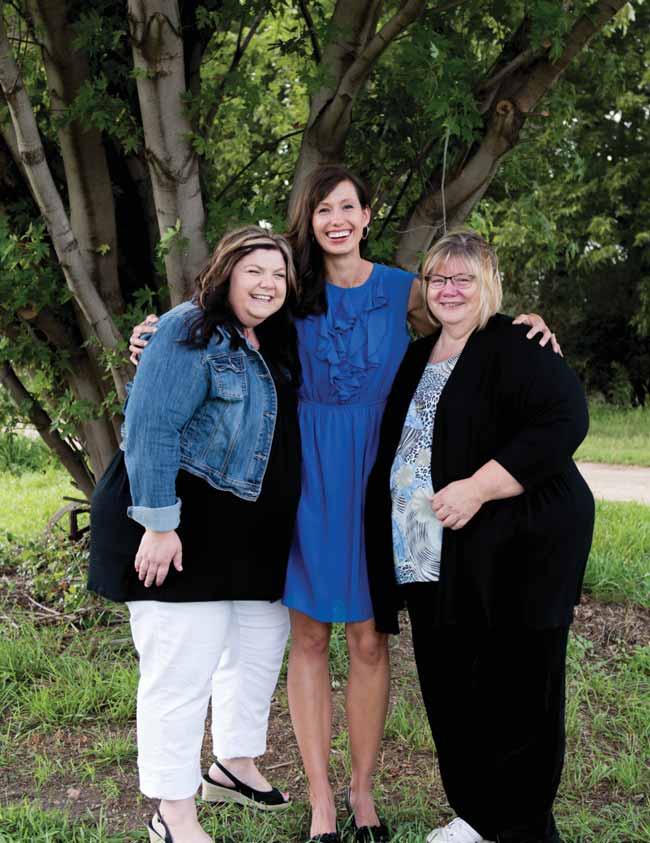


The Bible should inform our response as disciples of Jesus to the global refugee crisis.

Connie Faber Editor
Since few Westerners have actually seen war, we are unable to visualize the tragedy and suffering that comes with the kind of violence that drives people from their homes. Statistics can be compelling, but in early September it was an image of Syrian toddler Aylan Kurdi, washed up on a Turkish shore, that sparked international outrage. Pictures of a little boy in his red shirt and blue jeans opened our hearts to the struggles of 3.8 million Syrians who have sought refuge in other countries as well as the 7.6 million who are displaced within Syria itself. Do something, the world cried. Governments, including the United States, responded by increasing the number of refugees they would welcome.
World Relief, founded as the humanitarian arm of the National Association of Evangelicals and an agency that connects to our evangelical commitments, is one of nine agencies that will resettle the 85,000 refugees that the U.S. plans to accept in 2016. World Relief recently hosted a webinar during which staff members talked about the resettling process and how local churches can support refugees.
Mennonite Central Committee, the inter-Mennonite relief, development and peace agency that is also addressing the refugee crisis, represents our Anabaptist roots. MCC also recently hosted a webinar during which staff with MCC partners in Syria told how they are working with those who choose to stay in the Middle East.
It goes without saying that MCC and World Relief as well as many other faith-based agencies working to address the refugee crisis need our financial support. Just recently MB Mission opened a project account to support the work of Mennonite Brethren in Germany who are working with Syrian refugees coming to their country. But what else can we do?
See with God’s eyes. According to LifeWay Research, just 12 percent of American evangelical Christians say that the Bible is a primary influence on their views regarding immigration. Let’s not let a statistic like this be true of U.S. Mennonite Brethren regarding refugees. The Bible should inform our response as disciples of Jesus to the global refugee crisis. Both MCC and World Relief provide resources that can educate us about what the Bible says.
Advocate for peace. In the face of complex political, religious, historical and economic issues that are at the root of the current conflict in Syria, it may seem naïve to suggest that peace is the answer. And yet that is exactly what MCC partners like Riad Jarjour of Syria say. “Please work on ending the conflict and bringing peace,” says Jarjour. “Let’s rebuild our countries (so that) people stay and live as they did in the past.”
Followers of Christ Jesus are called to be God’s agents of change in a hurting and broken world. Deuteronomy 10:18-19 reminds us that God “defends the cause of the fatherless and the widow and loves the foreigner residing among you, giving them food and clothing,” and commands us to “love those who are foreigners.” God cares for the vulnerable and so should we. For additional information on ways to address the refugee crisis, visit www.usmb.org/refugee-resources.









Burket
Jessica Michele Conzen
For my Oma, the manger was a promise of something to
Lil Goertzen
We are reluctant to perpetuate the belief in Santa Claus, so why do my husband and I keep dressing up as Santa and Mrs. Claus?




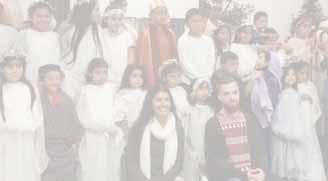


Roy Burket

John 10:11 focuses on two aspects of our shepherd: his identity and his mission.
His identity: Jesus says that he is the “good shepherd.” Jesus is a good shepherd because as a shepherd he is willing to lay his life on the line for his sheep. When compared to the hired hand (John 10:12-13), who cares nothing for the sheep and abandons the sheep when they are in danger, Jesus comes to our rescue and gives his life for us.
His mission: Jesus never wavers in his mission. His mission was to “lay down his life for the sheep.” So the question is, why does Jesus want to lay down his life for the sheep, for people like us that do not even know who he is?
Jesus, the good shepherd, died for us because we are sinners who need to be redeemed and reconciled to God. The Pillar New Testament Commentary says, “The words ‘for (hyper) the sheep’ suggest sacrifice. The preposition, itself ambiguous, in John always occurs in a sacrificial context, whether referring to the death of Jesus (6:51; 10:11, 15; 11:50; 17:19; 18:14), of Peter (13:37–38) or of a man prepared to die for his friend (15:13).” According to John 15:13, a person who lays down his life for his friends demonstrates the greatest love a person can have. This tells us that Jesus, the good shepherd, has the greatest love anyone can have for us; he willingly and voluntarily gives his life on the cross for us. Romans 5:8 says that Jesus died for us while we were still sinners.
Galatians 4:4 tells us, “But when the time had fully come, God sent his Son, born of a woman, born under law, to redeem those under law, that we might receive the full rights of sons.”
Ephesians 1:7 says that we gain redemption and forgiveness of our sins through the blood of Jesus that was shed on the cross.
In the Old Testament we read about the numerous sacrifices of animals whose blood was shed to temporarily cover the sins of the people. But in the New Testament we learn in Hebrews that Jesus sacrificed his life “once and for all” that we might be redeemed and reconciled to God. Hebrews 10:12,14 states, “But when Christ had offered for all time a single sacrifice for sins, he sat down at the right hand of God…. For by a single offering he has perfected for all time those who are being sanctified” (ESV). Take a moment to ponder the depth of the good shepherd’s love for us.
Roy Burket is senior pastor at Bethesda MB Church, Huron, SD.

“I am the good shepherd. The good shepherd lays down his life for the sheep.” John 10:11
November / December 2015 Volume 78 • Number 6
Connie Faber EDITOR
Myra Holmes ASSISTANT EDITOR
Shelley Plett GRAPHIC DESIGNER
Kisha Abbas, Kisha Photographic Design
COVER PHOTO (See story page 17)
The Christian Leader (ISSN 0009-5149) is a gathering place for the people, passions and mission of U.S Mennonite Brethren. The Christian Leader is published bimonthly by the U.S. Conference of Mennonite Brethren Churches. However, the opinions expressed here are not necessarily those of the church as a whole.
COPYRIGHT The articles printed in the Christian Leader are owned by the CL or by the author and may not be reprinted without permission. Unless noted, Scripture quotations are from the New International Version.
READER PARTICIPATION Letters to the editor should be 300 words or less and on one subject. Letters must be signed and include the writer’s city and state. Letters will be edited for clarity, appropriateness and length. Letters will be published, as space allows, unless marked, “Not for publication.” Readers interested in contributing essays for In My Humble Opinion and First Person should contact the editor. Freelance article submissions are welcome; a SASE must accompany articles.
SUBSCRIPTIONS $10 for six issues and $20 for 12 issues ($15, $30 in Canada; all other countries $25 for six issues); $1.50 per copy
CORRESPONDENCE: All correspondence, including subscription questions and address updates, should be addressed to Christian Leader Box 155, 107 N. Main, Hillsboro, KS 67063-0155 Phone: 620.947.5543
E-mail: christianleader@usmb.org
MEMBERSHIP The Christian Leader is a member of the Evangelical Press Association and Meetinghouse, an association of Mennonite and Brethren in Christ editors.
POSTMASTER Send address changes to Christian Leader, Box 155, Hillsboro, KS 67063. Periodicals postage paid at Hillsboro, Kansas.
The Christian Leader is published by

U.S. Conference of MB Churches

Terry L. Brensinger
The day church and seminary came together
Ifelt at times as though I was living a double life. On Sunday mornings, I stood behind the podium at Fellowship Chapel and preached to my rather motley looking congregation. The vice president of St. Barnabas Hospital was often in attendance, as was an executive from the New York Bible Society. Everyone else was rather nondescript. Few earned little more than minimum wage, and most had either lost a loved one to drugs or violence or knew someone who had. People of all colors, shapes and sizes, looking to God to get by in the challenging neighborhoods of the South Bronx. Then, on Monday morning, I drove my car to the seminary, attended my classes and bunkered down in the library. There, a small group of highly privileged individuals and I read theology books, analyzed pottery from the time of David and even learned how to read some of the languages that the Israelites and their neighbors spoke. It was as though I had left one world and entered a totally different one—two lives with no apparent points of contact.
One Sunday morning, however, something happened to narrow the gap. A young man who had earlier in life fried at least half of his brain on heroin shared a prayer concern with the congregation. Before long, others joined in—Bob, Iris, Willa, Ralph—requesting prayer, not so much for physical healing but for the courage to persevere through the difficulties of life. Strikingly, they feared, not cancer or heart disease, but unfaithfulness. They worried about following devilish voices that promised better days than God could ever provide.
As I listened, my thoughts drifted back to one of my classes the week before. We were translating ancient texts about Baal, a foreign god mentioned with some regularity in the Bible. Following Baal was always a temptation for the people of Israel, but the biblical writers never really explained why.
According to these texts, the reason was simple. Baal was the god of fertility, the god who “rode on the clouds.” Baal was the one who hurled lightning bolts through the sky and sent rain to water the earth. When life got tough and you struggled to put food on the table, Baal was the one to know.
“Ralph,” I chimed in excitedly when I regained my senses. “Your struggles are not unfamiliar to God. The Israelites wrestled with the very same issues of security and survival. Why, just this week in class, I learned that the reason the Israelites found Baal so enticing was that he promised wealth and prosperity when even God seemed hopelessly silent.”
“Really?” Ralph replied with unbridled curiosity and keen interest. “And what did God do to help them?” he continued. As I began answering the question, I sensed my double-life worldview and all of its artificial distinctions melt away. With a new degree of freedom, I looked appreciatively into Ralph’s eyes and thanked God for the insight that my education enabled me to provide.
Don’t get me wrong. “Double-life” tension still shows its ugly face once in a while. I occasionally find myself defending the value of a good, theological education when I hang out, as I often do, in various church settings. I likewise feel like an odd ball from time to time when I encourage theologians and biblical scholars to keep the transformative mission of the church first and foremost in their minds as they teach and write. For the most part, however, I am now at peace with myself. I’ve come to realize, largely through Ralph and everyone else at Fellowship Chapel, that we—the church and seminary—really can work together.
Terry L. Brensinger is president of Fresno Pacific Biblical Seminary, the Mennonite Brethren seminary located in Fresno, Calif.
As I began answering the question, I sensed my double-life worldview and all of its artificial distinctions melt away. With a new degree of freedom, I...thanked God for the insight that my education enabled me to provide.


Sullivan




Twenty-five feet. It’s not so very high up, barely even a third of the height of the mature, male red mulberry that holds my tree stand. It grows along the edge of the South Cottonwood River not far from the farm of my friends, Maynard Knepp and Carol Duerksen. Many days in the fall, from late September to the end of December, that’s how high I’ll be as I sit and wait and watch.
Bow season for deer has three distinct segments. Early season is green. Leaves are bright emerald, especially with the early morning sun filtering into the creek bottom or late in the evening as sunlight offers farewell to the woods.
Midseason is gold. Leaves begin to yellow and loosen their grip, sometimes raining gold as the trees give up their summer garb and strip to the brown nakedness of late fall. Eddies of wind play through the trees in the bottom, shaking the leaves loose in intermittent showers. I love to watch the golden rain it creates. There is also the frequent plunk of a hedge apple hitting the ground as Osage orange trees lose their grip on the green knobby fruits that have been growing all summer.
My favorite is the late season, white blanket into which God tucks creation for the long winter sleep. I am continually amazed at how swirling flakes and a downy, soft coverlet of snow can make the world so quiet. Motors cease to hum and whine. Traffic noise is muted. The cattle on the Knepp farm either can’t be heard or have quit their lowing. Birds and mammals are hushed, waiting out the storm. It is a peace that I can’t find anywhere else.
From my tree stand, 25 feet up in that mulberry tree, I can see so many things. Brightly

colored wood ducks quietly paddle along the creek. Turtles move upstream to the deeper holes where they will winter, buried in the mud. Raccoons and opossums forage in the leaves and shrubs, putting on a layer of insulation for the coming cold. A bobcat and her bob-kittens noiselessly stalk through the creek bottom, looking for an unsuspecting squirrel. Most have already spotted her and bark incessantly until she and her kits are long gone.
Oh, yes, occasionally I see deer. But some years, like this one, that’s a rarity.
I hunt because we use the bounty God provides to sustain us through the year. But even if I didn’t I would still love the quiet and peace that my little hideaway affords. It’s where the noise of my life—the phones, televisions, emails and faxes— can’t reach me. Those fade away and I am left with the silence and beauty of the creekbottom woodlot.
Jane Stout
It’s not a big wood, maybe 20 acres total snaking along the course of the creek. But it is where God comes to meet me, to soothe my hurt, encourage my heart and give peace to my restlessness. It is where God walks with me, talks with me and tells me that I am his own.
We need the meat for our freezer. Perhaps I need that woodlot even more desperately for my soul. Thank you, God, for my 25-foot hideaway.
Tim Sullivan is the Southern District Conference minister. He enjoys hunting, fishing, riding bicycle and showing his six grandchildren the wonders of God’s creation. He and his wife, Donna, live in Wichita, Kan. This essay first appeared in Purpose, a publication of Mennonite Church USA.





USMB hopes to raise $60,000 through online donations on Giving Tuesday to support church planting in 2016. Giving Tuesday, which this year falls on Dec. 1, is a global movement celebrating generosity.
“Giving Tuesday provides our USMB family with the opportunity to join together in giving, in just one day, to make a big impact for church planting,” says Don Morris, USMB interim executive director and director of Mission USA.
Last year, online donations to Mission USA on Giving Tuesday topped $50,000, which enabled Mission USA to partner in five new church plants in 2015. Morris hopes to raise even more this year. “That way, we’ll have the ability to help plant even more USMB churches in 2016. It takes a lot of financial resources to plant churches, to reach more people in more communities with the gospel,” he says. For more information, visit www.usmb/givingtuesday or follow #Together on Facebook and Twitter. —USMB
The North Carolina District Conference (NCDC) welcomed a new church when they gathered for their 75th convention Sept. 19-21 in Lenoir, NC. Delegates unanimously approved Assemblies of Trinity International (ATI), a church plant in Alexandria, Va., as a new NCDC congregation. ATI is the first Ethiopian congregation in the district and brings the total number of district churches to eight. The theme of the convention, “Come to Serve,” was reflected in a Friday evening youth program, Saturday workshops for youth and adults and a standing-room-only Sunday morning worship service.
Solomon Telahun, pastor of ATI, delivered Sunday’s keynote address. “A call to ministry is a call to serve the entire world,” he said. “Let us recommit to him who died for us; let us remember that God honors a life that was lived for him.” NCDC
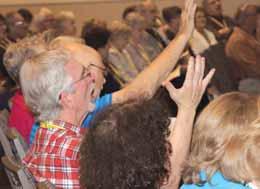

The first USMB gathering for senior adults hosted by MB Foundation (MBF), the stewardship ministry for U.S. Mennonite Brethren, drew 172 people to Overland Park, Kan., for Celebrate 2015. The Oct. 2-4 weekend event offered challenging messages, classic worship and timely workshops around the theme “This is my story” and provided time for attendees to renew old friendships and begin new relationships.
“I am blown away by the response from those who attended,” says Jon Wiebe, MBF president and CEO. “We had high hopes for this weekend, but the gratitude and appreciation expressed by those who came was more than anticipated. We are honored to serve this generation.”
The keynote speaker was Don Argue, former president of the National Association of Evangelicals. David Martens, director of contemporary Christian music at Tabor College, led worship times. The Ball Brothers provided a Friday evening concert and comedian Kenn Kington performed Saturday evening.—MBF
The 2016 USMB National Convention and National Pastors’ Conference will be held July 27-30 in Westminster, Colo. The speaker for both events will be Matt Heard, author of Life with a Capital L.
During the Pastors’ Conference, Heard will help pastors discover a ministry life that is “lavishly enjoyed, deeply experienced and exuberantly celebrated,” says Don Morris, USMB interim executive director. At the National Convention, Heard will focus on passion for reaching the lost, preaching the gospel and catching a collective vision for the future. “I am personally excited to have Matt Heard as our guest speaker,” says Morris. “What he brings is topnotch, practical and helpful.”
The theme for the July 2016 national events will be Press On. All activities will be held at The Westin Westminster in northwestern Denver. Donna Sullivan, USMB event coordinator, notes that the hotel is in a “relaxing, pastoral” area with scenic mountain views, a creek, walking trails and parks.—USMB USMB announces date, location for convention

byTheNumbers
5 minutes with...

Raised in a home with foster siblings and now as mother of two adopted children, Jamie Driggers of Hillsboro (Kan.)MBChurchhasalwayshadaheartforwidows, orphans and other marginalized people. Last December her advocacy for justice took a unique turn as she teamed with Dressember, an international campaign in which women wear dressesforthemonthofDecembertoraisemoneyandawareness to fight human trafficking.


What drew you to Dressember?
If I can wear a dress and help fight the exploita on of women, why wouldn’t I?
How does the campaign work?
We have fun with it, pos ng pictures on Facebook and telling people how they can give on our website pages. Some mes people just hand me money in the grocery store. Our team of six raised $2,890.
What impact does it have on the participants?
Every morning when it’s cold and we aren’t reaching for our jeans, we find ourselves praying for women who aren’t ge ng any choices.
What does Dressember mean when they refer to women who are “exploited for their femininity?”
In much of the world women are seen as an expense, not a gi . A baby girl might be drowned, parents mourn if their baby is not a son, dads sell their daughters for a dowry at 13. We need to educate women and show they can be produc ve ci zens.
Why is fighting for justice so important to you?
Most frequently reported ER incidents due to decorating involve
15,000 Number of INJURIES INVOLVING HOLIDAY DECORATING seen in the ER during November and December 34% falls 11% lacerations 10% back
U.S. Consumer Product Safety Commission, 2013

Isaiah 58 says if we want our light to shine we have to stand up for those who can’t stand up for themselves. The whole Bible from front to back says taking care of the poor is our responsibility.
Do you really think wearing a dress can really make a difference?
I believe in everyday advocacy. Small decisions ma er—our purchases, all our li le daily choices are going to make a difference in the end.
For more informa on find Jamie Driggers on facebook.com
MB Mission, the North American Mennonite Brethren mission agency, has formed a Midwest Mobilization Team to serve USMB churches in the Southern, Central, North Carolina and Latin America MB District Conferences. Stephen Humber, Denver, Colo., who was most recently a pastor at Stony Brook Church, a USMB congregation in Omaha, Neb., is leading the team. Joining Humber are Danae Schmidt, Hillsboro, Kan., Bob and Kelly Pankratz, Plevna, Kan., and Aaron Myers, Sioux Falls, SD. “Our new team will be spread geographically but is unified with the vision God has given us to launch a movement of missional leaders, nationally and globally,” says Humber.—MB Mission
Fresno Pacific Biblical Seminary (FPBS), the Mennonite Brethren seminary in Fresno, Calif., is again offering an Advent devotional. Daily meditations center on the theme, “Jesus Christ Our Peace,” and are written by seminary faculty, administrators, students and graduates, as well as faculty and administrators of Fresno Pacific University (FPU). The devotional will be available beginning Nov. 28 online at http://fpu.edu/advent, through an Android app on the Google Play store and in print through the FPU advancement office. Contact Connie McNeely at 559-453-7139 or connie.mcneely@fresno.edu for individual print copies.—FPBS
Enrollment for Tabor College’s 2015 fall semester is 729 students, which includes a 35 percent increase in graduate students. Tabor College is the Mennonite Brethren college located in Hillsboro, Kan., with a second campus in Wichita, Kan. Two years ago, Tabor College Wichita had 11 students enrolled in graduate programs; this fall, TCW has 42 graduate students. Of the 561 undergraduates in Hillsboro, 150 are first-time freshman and 54 are transfer students for a total of 204 new students this year.—TC
A record graduate enrollment this fall and last year’s large undergraduate graduating class shaped enrollment for 2015-2016 at Fresno Pacific University (FPU), the Mennonite Brethrenowned school headquartered in Fresno, Calif. These conflicting trends resulted in a total of 3,586 admitted students in fall 2015, down from 3,718 at the same time in 2014. The number of students in graduate programs rose to 1,224 in fall 2015, up from 1,180 the year before. Traditional undergraduate enrollment went down 10 percent to 1,099, due in large part to a large spring 2015 graduating class. In bachelor’s degree completion programs, headcount dropped 4 percent to 1,263 students.—FPU
Herald Press has released Deuteronomy, the 29th volume in the Believers Church Bible Commentary series, authored by Gerald E. Gerbrandt of Canadian Mennonite University, Winnipeg, Man. Written for lay readers, pastors, teachers and Bible study groups, the commentary considers the themes that tie together the Old Testament, New Testament and life in the modern world. The Believers Church Bible Commentary is a cooperative project of Mennonite and Brethren conferences in the U.S. and Canada. Deuteronomy is available at www.MennoMedia.org and bookstores.— MennoMedia
By David Faber





hat has gone wrong with Christmas? For many, instead of being a time of joyful celebration, the Christmas season has become a time of stress, disappointment and debt. Has our consumer culture stripped Christmas of its true meaning? Are the answers as simple as cutting back and spending less time and money on decorating the house and yard, travel, parties and shopping for and wrapping gifts? If we simplify our celebration will we be better followers of Jesus?
The problem with Christmas is not that some people say “Season’s greetings” rather than “Merry Christmas.” The problem is deeper than that. Simply put—in fact, maybe too simply—our celebration of Christmas has been corrupted by sin.
Perhaps this answer will be a bit more helpful if we note one aspect of the nature of sin. In Not the Way It’s Supposed to Be: A Breviary of Sin, Cornelius Plantinga, Jr., notes that, “Sin is a parasite, an uninvited guest that keeps tapping its host for sustenance.” That is, sin acquires its attractiveness and vitality by latching onto the good that is present in something and then deceiving us.

So, what is the good in our celebration of Christmas off of which sin feeds and thereby corrupts? I suggest it is the good of genuine, extravagant gifts. God is the giver of genuine gifts, and God is extravagant as a giver. As the book of James says, “Every good and perfect gift is from above, coming down from the Father of the heavenly lights” (James 1:17).
Defining a genuine gift
Let’s unpack what we mean by a genuine gift. A genuine gift is one that the giver has no obligation to provide. If there is an obligation for one person to provide another with something, then we have a negotiation or a bargain of some sort. When something good is provided freely without any reciprocal expectation, then something is a genuine gift.
It is not bad to have exchanges that involve obligations to both parties. That is what good, honest work is, after all. I, the employee, offer you, the employer, my labor in exchange for appropriate wages. Employment is a good thing, but it does not involve gift giving.
The error of our hyper-consumerism does not lie in its extravagance. And it will not be fixed by simply giving less.
And God is an extravagant giver. The creation itself—in all of its vast variety and mystery—is a gift. God was not obligated to create; there was not something missing from the life of the triune God that could only be filled by the act of creation. Creation comes from the overflowing of God’s love. Similarly, God did not have to redeem rebellious humanity. The choice to offer healing to the damaged creation was an act of love, not of necessity. Part of its extravagance is the profound suffering that God endured to provide this gift. And God promises a new heaven and a new earth that are characterized by extravagant beauty.
Of course, extravagance is relative to one’s resources. God has no limitations and so God’s extravagance is infinite. One need not have large amounts of resources in order to be extravagant. And extravagance should not be taken as license to be irresponsible. But neither should the corruption of the celebration of Christmas be an excuse not to imitate God in our extravagant gift-giving.
The error of our hyper-consumerism does not lie in its extravagance. And it will not be fixed by simply giving less.
The problem with the way much of our culture and many of us celebrate Christmas is that we have distorted—indeed, virtually reversed—the role of giver and receiver in the exchange that we call gift giving. In genuine giving, the giver—based on love of and understanding of the receiver—uses the gift to bring delight, wholeness and life to the receiver. And the receiver accepts the gift with an attitude of wonder as to why this gift was chosen.
In false giving, the giver uses the gift to try to make the receiver like the giver, and the receiver expects the gift to be something that she desires. In genuine giving, both giver and receiver are focused on the other; in false giving, both giver and receiver are focused on themselves.
Consider this situation described recently in an advice column in our daily newspaper. A young woman received a crystal paperweight in the shape of a heart as a gift from her mother. Her response upon opening the gift was, “This is so not me.” She wrote that she and her husband are not “keepsake” people. After some negotiating about exchanging the gift for something else, the mother emailed her daughter that she could exchange it for another pa-
perweight or send it back and it would not be replaced. “My feelings are already a bit bruised either way,” the mother wrote her daughter.
If this young woman had been thinking about her mother instead of herself, she might have thought: “My mother knows me well, and she knows that I don’t generally buy this kind of thing. I wonder why she wanted me to have this? What is she seeing that I am missing?”
Similarly, the cultural—as opposed to the historical—understanding of Santa Claus provides a nice example of false giving. Santa Claus knows a little bit about you, enough to know whether you are nice enough to receive gifts. But he doesn’t really know us very well. So, we have to provide him a list of what we want, and he will fulfill that list. Santa Claus’s gift giving is not based on his intimate knowledge of us and his desire for us to flourish. So, he just asks us what we want.
A Santa Claus God?
Croatian-American theologian Miroslav Volf writes in Free of Charge: Giving and Forgiving in a Culture Stripped of Grace, “What is the difference between a Santa Claus God and a gift-giving God? The bare bones answer is this: A Santa Claus God gives so we can have and enjoy things; the true God gives so we can become joyful givers and not just self-absorbed receivers.”
It is fitting that Thanksgiving and Christmas are so close to one another on the calendar. It is even more fitting that Thankgiving lies at the end of the church calendar and Christmas at the beginning. The end of a year is typically a time of reflection, of looking back. Gratitude is a backward looking emotion. We can look back at the gifts given us by our extravagant God and ask, “What did God see in us that he provided these gifts?”
The season of Advent looks forward to the new year, to a gift given to all humanity. To echo Volf’s idea, we can ask ourselves, “How can we use the gifts from God to become extravagant, joyful givers ourselves?” We don’t free ourselves from the tyranny of a consumerist culture by giving less; we free ourselves by giving and receiving in a more genuine way.
David Faber is professor of philosophy and religious studies at Tabor College, the Mennonite Brethren school headquartered in Hillsboro, Kan. He is a member of Ebenfeld MB Church in Hillsboro.


Growing up, Christmas Eve was always a celebratory and festive day. My sister and I would help Oma, my grandmother, pick out and decorate the Christmas tree. We’d mill around the kitchen, hindering more than contributing to Christmas Eve dinner, secretly hoping to eat the marzipan stolen, a German bread filled with nuts, raisins and almond paste, as an appetizer rather than a dessert.
As night approached, we’d sing O Tannebaum as we watched the candlelight flicker on the silver tinsel that decorated the tree. Afterward, my sister and I were banished to the back bedroom where we would play until we heard sleigh bells, the signal that Santa had visited. That 15 or 20 minute wait felt like an eternity! When we heard the jingling bells we were free to leave the room and open the beautifully wrapped gifts that had appeared.
But the thing I most remember about this day is my Oma’s nativity set. It occupied center stage on the coffee table, surrounded by pine branches, garland and candles. While Mary, Joseph and the wise men made their appearance early in the month, Jesus’ manger remained unoccupied until December 24.
As kids, my sister and I always chuckled at Jesus’ absence. We knew the story. We knew he belonged in the manger. It wasn’t a secret. Why delay putting him in his designated spot?
However, as an adult, I now recognize that my Oma knew something we had yet to discover. What we failed to comprehend, but what Oma so profoundly understood, was the meaning of this night—the magnitude of God’s presence in human form and the significance of God coming to his people.
The Gospel of John starts with a mini-introduction to Jesus. As part of this introductory biography, we’re told that the Word, who was God, “became flesh and made his dwelling among us. We have
seen his glory…” (John 1:14, emphasis added). What is fascinating about this verse are the italicized words.
When it comes to communicating, we know that words matter. Words have significant meaning and because of this we choose them carefully. Here we see John, the author, doing the same.
The Greek word for “dwelling” is the verb skenoo, which means “to tent” or “to tabernacle.” Using this definition, we can say that God “pitched his tent among us,” that he “tabernacled with us” or that he “moved into the neighborhood” (John 1:14, The Message). While this word choice may seem a bit odd to us, John intentionally used it to make a statement about what God was doing and who he was declaring himself to be in the person of Jesus.
To understand what John is communicating, we first need to know the significance of this word and the imagery associated with it in the Old Testament. The words “tent of meeting” and “tabernacle” appear in the book of Exodus, Leviticus and Numbers and are often used interchangeably.
In Exodus, after God delivered the Israelites from Egyptian slavery and as they began their 40-year wilderness trek, he instructed Moses to construct a mishkän, a dwelling place. This dwelling place was the tabernacle. It was the physical location where God met his people and served as a portable worship and sacrifice center for the Israelites during their wilderness wanderings.
While the tabernacle was under construction, Moses pitched the tent of meeting, an interim meeting place that was later absorbed into the tabernacle. It was here, and in the tabernacle, that God visited with Moses and by extension the Israelites. While the actual, physical structure was important (11 of the 40 chapters in Exodus are devoted to the tabernacle’s construction), it’s what filled this space— God’s presence, God’s glory—which was most significant.
God’s presence and glory is often identified by the shekinah. Essentially, God’s presence and God’s glory equals shekinah. We see the shekinah in the cloud that led the Israelites out of Egypt, that descended upon Mount Sinai when delivering the covenant and that took up residence in the tent of meeting and the tabernacle.
The cloud signaled God’s visit and was proof of God’s promise to dwell with his people. When “the cloud covered the tent of meeting, and the glory of the Lord filled the tabernacle” (Exod. 40:34), Moses and the Israelites waited expectantly at a distance, anticipating this encounter with the divine. In this moment, God’s people beheld his glory; they witnessed God’s presence.
In these divine visitations, God revealed his desire for relationship, nearness and intimacy. In this dwelling place, Israel discovered that God was not far off, distant or uninterested in their lives. Rather God’s proximity was evidence of his desire to interact with and lovingly guide them. This closeness, this relationship, was what it meant for God “to tent” or “tabernacle” with his people.
Anticipating God’s presence
John draws upon this imagery in verse 14 of his Gospel. Using this same terminology, John communicated that once again God was dwelling with his people. However, this time, he was no longer tied to a physical structure but was made visible in the person of Jesus. God was tabernacling with us but in a very different way.
Rather than a grand tabernacle, God’s dwelling place was a human being. Rather than appearing in a cloud, God’s glory, God’s presence, the shekinah now appeared in Jesus. This was the height of God’s self-revelation. Jesus was God’s ultimate expression of his desire to relate to and exist beside his people. Jesus was the new meeting place.
This is what my Oma so profoundly understood. This is what she saw in the empty manger and why she held off placing Jesus in his assigned spot.
Just as Moses and the Israelites waited expectantly for God’s presence to fill the tabernacle, Oma waited expectantly for God’s presence to fill the manger. For her, the manger was a promise of something to come. It wasn’t the physical space—the manger itself—that was important. Rather, it was the one who would occupy it on that sacred night that mattered most.
She understood that God was reenacting his tabernacle revelation but now in human form. God’s promise to dwell with his people would be realized in the form of a babe and in the life of Jesus. His nearness would be made evident, and his desire to be known and to know his people would manifest in the flesh.
Looking back, I can see the expectation in Oma’s eyes when she eventually placed Jesus in the manger. Like Moses and the Israelites, she beheld God’s glory, but now, like John, she recognized God’s glory in Jesus. She anticipated this moment all month long. She waited in hope, knowing that God was coming to his people and that this would be the greatest moment of his interaction in the world.
Something my sister and I once thought humorous is now a tradition I’ve adopted. I not only construct my nativity set with my Oma’s care and concern, but I leave the manger empty until December 24. While I do this in memory of Oma, more importantly, I do it as a reminder of the anticipation we should all have.
The empty manger symbolizes what awaits. It represents our eagerness for God to fulfill his promise to dwell with us. This Christmas season, I encourage all of us to wait with just as much anticipation as my Oma. I pray we too behold God’s glory in Jesus, making time to ponder its game-changing significance. May we await this divine visitation with hope, expectation and faith.
Jessica Michele Conzen is a Fresno Pacific University adjunct faculty member teaching in biblical studies and early childhood development. She is a 2013 graduate of Fresno Pacific Biblical Seminary with a master’s degree in theology. She blogs at musingsofatheologist.wordpress.com.
By Lil Goertzen

Santa and I walk into the Christmas party for the children of hospital staff to the sound of youngsters cheering and clapping. We make our way around the room greeting parents, clowns, organizers and, of course, the children. When the photographer is in place and the lights are adjusted, Santa and I find our places in the big chairs. The anticipation builds as the children line up with the help of an elf. Soon it will be their turn to meet Santa!
Once they are settled on his knee, children are often intrigued with Santa’s beard. They tug at it to make sure it’s real. The beard doesn’t disappoint. It’s real.
Santa asks questions of the children: How is your day going? What is your favorite thing to do at school? Do you have brothers and sisters? The question, “What do you want Santa to bring you for Christmas?” never passes Santa’s lips. Anxious parents are usually the ones who prompt the child to rattle off the Christmas wish list. “How do kids know about all this stuff?” wonders Santa as the little voices recite the suggestions.
Santa, Mrs. Claus, the child and often the rest of the family pose for a series of photos. Then they are off to the next activity, with gifts from the staff social club fund in one hand and candy canes in the other. Another eager family comes for their chat and photo. And the cycle is repeated until every child has had the opportunity to visit with Santa.
My husband and I have been playing Santa and Mrs. Claus for five years. It started when George decided it would be fun to hand out Halloween goodies to the neighborhood children dressed up as Santa. When he was asked to be Santa for a children’s party, George agreed to do it on the condition that I would come as Mrs. Claus. I purchased fabric, made my outfit and joined him dressed as Mrs. Claus in a red dress, white cap and apron. Before we knew it, we were appearing at Christmas events and parties at hospitals, senior centers, garden centers and more.
The response was enthusiastic, but George was troubled. George was raised in a conservative Mennonite home and community. Great importance was placed on being truthful and not confusing fiction and reality. For him to now play the part of an imaginary character was cause for great inner turmoil. How in good conscience could George put on the red suit, assume a persona and interact with others while carrying this inner struggle?

The dilemma arose each time George prepared for another appearance. “Santa is not real,” George would think while pulling on the long black boots and adjusting his gold-rimmed glasses. The reluctance remained as he would grasp the black leather strap with the gold color jingle bells, and we would head out the door.
So why does George continue to don his red suit even when he is reluctant to portray a fictional character that so many children believe is real? The answer lies in what is real.
Much better thanks to Santa
One of our more memorable experiences as Santa and Mrs. Claus was our visit to a geriatric psychiatric ward. Along one wall, an elderly fellow sat in a wheelchair, leaning forward, staring at his tray. Santa’s entrance with jingle bells and hearty “ho, ho, ho” did nothing to cause him to stir.
After greeting other residents, Santa approached the wheelchair-bound gent. Touching his arm, Santa asked how his day was going so far. Slowly, the man raised his unsteady head, his eyes locked with Santa’s and he responded, “Now that I’ve seen you, Santa, much better.”
As we were leaving, we learned that this elderly man had not responded to anyone in almost three days.
George—or should I say “Santa”—continued his walk through the ward. People who have huge responsibilities and work under great pressure became giddy little kids when Santa came around. Cell phones appeared from pockets and suddenly groups of staff members, including doctors and nurses, were crowding around Santa—everyone wanted their photo taken with him.
“My kids will be SOOOO jealous! They won’t believe that I just met Santa!” And in an instant, the photo with Santa and staff was sent off to another country, sharing the excitement of meeting the man in red.
Santa and Mrs. Claus were invited to appear at a garden center where we sat in a big, red antique sleigh on a seat draped with a heavy fur blanket. Parents bring their children to visit Santa at this particular location because the young ones are comfortable with the relaxed atmosphere. Kids aren’t rushed to spout off their want list. Santa even multitasks, listening to a child seated on one side while on the other he is juggling the family’s squirmy puppy that struggles to stay put for the photo.
One of the children Santa visited with that day was a special needs child. His mom was a single parent, and as she watched Santa cradle the boy and talk to him, not rushing on to the next photo op, tears ran down her cheeks. The child may not have known what was happening, but Mom knew. The connection between Santa and the child was captured in a single frame, a treasure for a mom to keep.
“You’re the best”
“Christmas in July” at a campground in North Dakota is one of our favorite resting spots. The red costumes come out of the red suitcase and we position ourselves along the parade route in the campground. A big bowl of candy entices everyone to stop by for a chat.
Last year after groups of families had made their circuit of the campground, admiring the decorated trailers and campsites, a dad in his mid-30s returned to Santa and Mrs. Claus. With tears in his eyes, he hugged us and repeated, “You are the best! You have no idea what you’ve just done for me. You’re the best.”
George and I will likely never know what prompted this young man’s response. But something somewhere was stirred.
Weeks after the Christmas in July weekend, Santa and Mrs. Claus were in our regular clothes, seated in a restaurant by the window. A young boy and his family walked by the restaurant window, and the youngster recognized Santa from the campground. He announced to his dad, “That’s not the real Santa. This guy is wearing a wedding ring.”
What is real? Laughter. Smiles. Tears. Conversation. Hugs. Encouragement.
The dots may not always connect back to the Jesus story. But when George, dressed as Santa in his signature red suit and white beard, talks with folks, they are meeting the genuine George, a real man who is a husband, father, grandfather and friend. And perhaps in seeing the real George, people get a glimpse of the real Jesus.
George and Lil Goertzen have been putting on their red suits at Christmas since 2010. They live in Winnipeg, Man., where they attend Morrow Gospel Church, part of the Evangelical Mennonite Mission Conference. Lil is editor of the EMMC Recorder.
South Dakota woman finds dramatic transformation in Christ
Nikkie Duin, of Sioux Falls, SD, always believed in God. But Jesus? Christian faith was “hocus pocus,” she thought. “I thought it was like a magic show,” she says, “something fake you believed in so you didn’t have to deal with real life.”
Now, Jesus is very real in her life. “Christianity is not fake at all,” she says. “You can feel it; you know it; you can hear God’s voice.” And when people ask for a reason for the dramatic transformation in her life, she smiles and tells them, “It’s Jesus hocus pocus.”
Duin’s first encounters with spirituality no doubt influenced her view of faith as something magical. Until fourth grade, Duin lived on the Yankton Sioux reservation in South Dakota. Her aunts and cousins were heavily involved in Native American rituals and encouraged her to participate, too. “I felt like that was something I wanted to be part of,” she says.
She tells stories of prayers to the ancestors, of mysterious experiences complete with strange lights and sounds. But such experiences left Duin with a sense of fear, not peace. That fear—especially fear of death—became an ever-present force in her life. Even as an adult, she lived under the constant dread of death, especially the death of her parents, husband or children.
When she was in elementary school, her family moved from the reservation to Sioux Falls, and Duin became fast friends with Michelle Martens. That friendship
proved to be one God would use to draw Duin to himself.
Martens describes her friend as fun-loving, outgoing and funny—always the life of the party. But she also had a temper that Martens describes as “scary” and that Duin herself admits to.
“I was always on the edge,” Duin says. Relatively small offenses would spark a blow-up.
Duin says she always believed in God—she saw a created world too beautiful to be the result of mere chance— but never heard about or understood the Jesus part of the story. “I was searching for God, but I didn’t know that,” she says.
During college, curiosity inspired her to visit various churches “to learn,” but nothing she learned inspired commitment. She graduated with a teaching degree and began working at a tribal school, where once again she became heavily involved in Native American spirituality, even leading students in praying to Native American gods.
But none of it filled the emptiness. “I still never felt very full, like I was still missing something,” she says.
So she continued searching, hoping to find peace through friends or partying. She married and had two daughters, but even the “American dream” left her lonely.
“I always felt so empty,” she says.
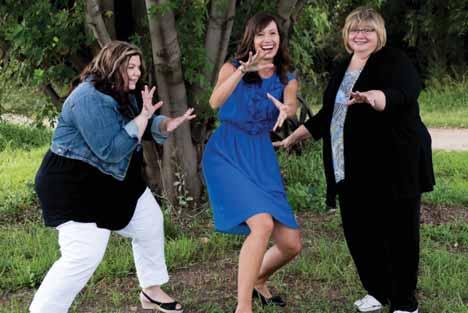
Duin remained close with friends from elementary school, including Martens, who had known Christ since childhood. When Christ Community Church (CCC), Sioux Falls, began, Michelle and her family became part of that Mennonite Brethren church plant.
Duin says that Martens’ involvement in a dynamic, healthy church like CCC was an important part of her journey to Christ. “They showed God’s love, and that’s just what I needed.” As a child, Duin associated church with hopeless, “overwhelmingly sad” funerals; as an adult, she saw many friends who considered church an obligation. But Martens was different; she was excited about her church community.
Martens sometimes invited Duin to CCC events, like one memorable family picnic. At that picnic, Duin suddenly turned to Martens and asked, “What’s up with this Jesus hocus pocus?”
Duin says she had long been curious, but wasn’t sure who or how to ask until then. “I was close enough to Michelle to ask her,” she says.
For her part, Martens was stunned by Duin’s question, asked in what Martens calls “a very crazy, theatrical way.” Martens recognized the importance of the opportunity but felt unequal to the task. So she sought help from her mother, Connie Buskohl-Barney—also an attendee of CCC and long-time influence in Duin’s life. Buskohl-Barney says she prayed for the right words, then started with the basics: Do you believe in God?
Nikkie looked at her daughter—a sure sign of a loving creator—and said, “Of course!”
From that foundation, Buskohl-Barney proceeded to talk about Jesus and explain the gospel. Martens recalls it as a good conversation and a good model for how to lead someone to Christ. But Duin didn’t get it. She didn’t make a commitment to Christ that day.
“I blew it off,” she says. And she withdrew from church.
“I get it.”
Still, God was pursuing her. Buskohl-Barney tells of a deep conviction of Duin’s “godless” state and the need to pray for her salvation. Martens remembers snippets of conversations and questions about faith. “In the in-between, (God) was showing her that he was right there,” Martens says.
Duin’s daughter loved Sunday school and kept asking to go back to CCC. Duin finally gave in
and attended a Sunday morning service at CCC. She was distracted by getting her kids settled into their classes, and she missed part of the sermon by then-pastor Rod Anderson.
But during one particular worship song, the gospel suddenly made sense to Duin. The worship team sang of peace and joy in Jesus. “That was who I was searching for my whole life,” she says.
“I knew that’s what I wanted. I wanted peace that was overflowing. I wanted love that was unending.” Later, she hugged Martens and told her friend, “I get the Jesus hocus pocus.”
A dramatic transformation
The change in Duin was dramatic. BuskohlBarney says, “It was an immediate switch for her.”
The constant fear of death? Gone. The quicktrigger anger? Gone.
In their place, she has the happiness, peace and joy she longed for, even in the face of trials such as a cancer scare. The change is so noticeable that an old friend asked over dinner what makes her different, and a casual acquaintance said she even seems taller. Her husband, Frank, marvels that she is unruffled by the same kinds of things that used to set her off.
“The old Nikkie is gone and I’m so glad that Jesus is here and living through my life,” she says.
Martens describes Duin now as centered, having a purpose and a “God-intended heart.”
Her theatrical bent now takes shape as a passion for telling others about Christ, and “Jesus hocus pocus” serves as her signature conversation starter.
The Duin family attends CCC, where Nikkie teaches in the children’s department and volunteers with the youth ministry. Whereas church was once a place of sadness or a place to explore intellectual curiosity, Nikkie now calls it her “fuel” and “center point.”
She says, “I don’t think I would be as strong in my faith without my church.”
And what if CCC had never been planted, or if her friends had never had the courage to invite her to church?
“I probably wouldn’t know Jesus still,” Duin says. “Be bold in your faith. Don’t be afraid to ask someone about Jesus, to invite or ask them to come to church.”—Myra Holmes
Last Christmas, a tamale dinner and Christmas program drew a record crowd into the Selma (Calif.) MB Church and helped workers there reach out in a difficult neighborhood.
Selma, Calif., is a “barrio.” Here, Hispanic surnames are dominant and poverty is rampant. A recent drive-by shooting claimed the life of a 14-year-old. Migrant workers seek temporary housing in garages and backyards. Intact families are the exception.
In this difficult setting, Selma MB Church seeks to share the love of Christ. Although the church is a project of the Pacific District Conference’s Board of Home Missions, the term “church plant” doesn’t quite fit. Volunteer Don Enns says the Selma work is more similar to a cross-cultural mission station than a typical church plant project. Even in its sixth year, the Selma church “continues to be more of an immigrant ministry or preaching station,” he says.
Spanish-language Sunday morning services are led by pastoral couple Alfredo and Elva Cardona. Local residents Urbano and Esther Gonzales help with teaching, music, pastoral care and facility maintenance. Part-time youth directors Brad and Delilah Isaak run an English-language children’s program on Sunday evenings; Brad also meets with local teens after school on Tuesdays.
Other core leaders come from Reedley (Calif.) MB Church. “We’re grateful for [Reedley MB’s] blessing and prayers,” Enns says. He and his wife, Martha, lead a Bible study during the Sunday morning sermon time for those who prefer English. Another Reedley couple, Bill and Paula Olinger, use their motor home to pick children up and bring them to church, which is key to getting them there.
Measurable progress for the Selma church is slow, as is often true in a mission setting. The church might minister to a total of 40 or 50 people over the course of a weekend; the youth ministry would include about 60 youth–if they all came at once. Vacation Bible school this past summer had an average attendance of 67.
For several years, the Isaaks have put together a modest children’s program at Christmas; last year, the church added a tamale dinner in an attempt to draw parents. It worked. The evening program drew over 100—a packed house in a building that holds about 80.
Children presented the Christmas story through Scripture readings, costumes and carols. A video of the past year’s children’s activities helped to familiarize parents with the work of the church, and leaders issued a Spanish-language invitation to Sunday mornings.
Although most of the parents haven’t darkened the door of the church since, Enns is not discouraged. “I believe we’re growing as we’re building more friendship and relationship in the neighborhood,” he says.
As workers patiently “wait for the Word of God to penetrate,” as Enns says, they prepare for long-term ministry. With support from the PDC’s Board of Trustees, the church has purchased a small, 100-yearold house across the street and hopes to renovate it as a home for the Isaaks, who will live there as neighborhood missionaries.
As for this Christmas, Enns says the church will undoubtedly do some kind of children’s program again–with or without tamales–to try once more to connect with the parents. –Myra Holmes

Hospitality is typically associated with sharing a meal or offering a guest bed. But Watershed Church, Kansas City, Mo., is taking hospitality to a new level with what they call “Hospitality House.”
Like many creative ministries, it began with a “what if.” About two years ago, during some conversations about vision, Watershed recognized both gifts of hospitality in their congregation and a desire to offer a deeper kind of hospitality. Pastoral couple Paul and Amanda Bartel began to imagine what they and Watershed could do if they had the space: “What would it look like to truly host
Bartel says they haven’t yet encountered such a situation, but if and when they do, they plan to direct the person toward more appropriate resources. That, too, is a form of hospitality.
A key piece of the dream was having a Watershed couple live in the house and serve as hosts.
“We didn’t want this to be something that happens in isolation,” Bartel says. “If we offered this to people, we wanted it to be a place that we could walk with them on their journey while they were there, and that looks different each time.”

people in times when they really need a space?” recalls Amanda Bartel.
And then they asked, “What if we had a whole house?”
That “what if” led to the spring 2014 start of Hospitality House, a literal house in the Watershed neighborhood that the church offers, rent-free, to those in their community who are in some kind of transition. Guests might be between houses, for example, or in need of a place to stay while making changes in their lives.
Bartel is quick to point out that Hospitality House is not a safe house, a rehab facility or a counseling service. While Watershed wants to serve their community, they recognize that they are simply not equipped to provide support for issues like addiction, abuse or mental illness.
Bartels approached Andy and Melissa Ussery, recently married Watershed attendees who did not live in the neighborhood but had expressed an interest in moving closer. More importantly, the Usserys are gifted in ways that make them “perfect” for the role, according to Bartel. Melissa has a knack for sensing needs and finding ways to serve; Andy is good at connecting with others.
Bartel says that the couple deliberated for “about a day” before jumping in wholeheartedly.
Melissa says, “Andy and I thought it would be a great way for us to serve, to get to know the neighborhood more.”
As host couple, the Usserys offer everyday hospitality and look for ways to serve. That might mean sharing a meal, having conversations about who does the dishes, offering a listening ear or connecting guests with others who can help meet a specific need.
Bartel says, “It’s been great to watch them love people in that house.”
In order not to burden the church budget, the Bartels purchased the house in the Waldo neighborhood, the area the Watershed congregation calls home. The church rents the house from Bartels, and the Usserys rent from the church. The guests, of course, live in the house rent-free.
The house has two levels: The Usserys have some private space on the upper level, while the guests have rooms on the lower level. The kitchen and living/dining area on the lower level are shared spaces.
The house also has a large yard and garden area, which provides space for Watershed gatherings, such as their annual Easter feast. Bartel says they hope to create a community garden, although first efforts this summer were less than successful: “This year all we grew was for the squirrels.”
The house wasn’t yet furnished when Watershed had the opportunity to host their first guests: a Watershed family in transition to a new city. The family’s house in Kansas City sold more quickly than anticipated, so they found themselves in need of a place to stay until their move.
The house hasn’t been empty since. One guest was a young woman from Honduras who was in the area briefly to make connections for her family’s coffee business. Another was a college-bound young man who needed to separate himself from an unhealthy home situation. And a family from Martinique stayed at Hospitality House while they got settled as teachers in Kansas City.
Listening and discerning
Guests find Hospitality House through word of mouth, and Bartel serves as the first contact. The application process is one of listening and discerning rather than formal paperwork. Conversations always include the Usserys and often include Watershed pastors Paul Bartel or Jason Phelps.
“We try to ask good questions, listen well and be discerning,” says Amanda Bartel. They talk about what brought the potential guest to this place of transition, why Hospitality House would be helpful, goals for the stay and how Watershed might come alongside during their transition: “What will this time allow you to do, and how can we partner with you to accomplish those goals?”
Guests don’t have to attend Watershed or make a profession of faith to stay at Hospitality House. Guests are clearly told this is a
ministry of Watershed, and they are always invited and welcomed to various Watershed gatherings. Some choose to accept such invitations; some don’t.
The house provides opportunities for all Watershed attendees to engage in hospitality.
“It allows for many different avenues to get involved in ways that fit them and also stretch them,” says Bartel.
Getting the house ready, for example, required the help of those skilled in fixing leaky sinks and painting decks, those with an eye for beauty and decor and those with generosity to donate beds, toys, sofas and cash. Some Watershed folks clean to prepare for each new guest; others enjoy tending the yard and garden.
Furthermore, each guest has different needs, so opportunities to practice hospitality vary accordingly: play dates for children, rides, care baskets, meals or gift cards. One man from Watershed had the time and knowledge to help the family from Martinique get drivers’ licenses, hunt for housing and learn the area. For the college-bound guest, hospitality looked like a graduation party to send him off with laundry soap and school supplies.
“It’s been amazing to see how each person can bring something new and unique to serve our guests,” says Melissa Ussery. “Who knows what God will do with the connections that we’ve made thus far?”—Myra Holmes
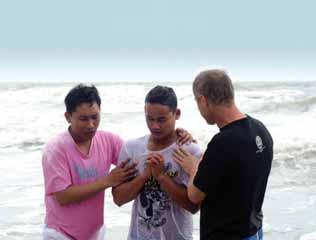
After the children’s Christmas program each year at Bethany Church, Fresno, Calif., attendees receive “toots”— bags filled with an apple, an orange, candies and nuts. It’s a simple tradition that’s been carried on since the church began in 1942.
Like Bethany, many USMB congregations have given out similar Christmas treat bags for as long as anyone can remember. A few congregations still call the gift bags “toots” or “tutes,” from a German word meaning “bag.” Others simply call them Christmas sacks or treat bags.
According to Peggy Goertzen, director of the Center for MB Studies, Hillsboro, Kan., the tradition has its roots in the late 1800s, when giving sacks of treats to children was a common practice in many Mennonite Brethren and Krimmer MB homes. Resources were scarce in these immigrant communities, so a piece of fruit and some candy or nuts was a special gift.
Sometimes, children would receive multiple bags as they attended various celebrations with extended family, and, as children will, they would get increasingly excited with each gift sack. Goertzen tells of one gentleman who told her, “I grew up with Christmas sacks. One Christmas I had four!”
Eventually, local churches embraced the gift bags as a way to give something to children, and it became a treasured tradition.
Linda Esau of Ebenfeld MB Church, Hillsboro, Kan., says that in the early days the church even appointed men to guard the bags overnight so they wouldn’t disappear.
Today, it remains a fun way to treat attendees and reach out to vis-
itors. Sylvia Dudo, of New Life Fellowship, Grant, Neb., says, “It is fun and a good way to remind people about why they are giving presents at Christmas.”
The contents of the bags haven’t changed dramatically over the years. Most still usually include fruit, candies and nuts that are given in a plain brown paper lunch sack. At Madera Avenue Bible Church, Madera, Calif., the bags include pistachios grown by a farmer in the congregation. Some churches add small items like bookmarks, pencils or ornaments.
Some churches give the bags only to children. But it seems all ages enjoy the bags, so many churches now give the bags to all ages. Vince Balakian of Reedley (Calif.) MB Church, where they distribute about 2,500 bags annually, says, “I’m not sure who enjoys them more—the kids or the older generations.”
For those older churchgoers, the bags often conjure childhood memories and serve as a reminder of a time when an apple and a few candies made them feel rich.
“To continue this practice is a reminder of where we have come from and what God has blessed us with—a reminder that the smallest gift costs something, and gratitude to God is the most appropriate response,” says CMBS’s Goertzen. –Myra Holmes










Don Morris Mission USA director

Support the USMB Giving Tuesday goal of $60,000
#Together, in one day, you can help plant at least four new Mennonite Brethren churches. By supporting Mission USA and our Giving Tuesday campaign on Dec. 1, 2015, you can help us reach our goal of raising $60,000 for MB church planting in 2016.
Last year on this special day we raised over $50,000. Mission USA’s commitment to a new church plant is typically $15,000 per year for the first three years, so these funds gave us a headstart in planting the five new churches that were born in 2015. Now we’re praying to raise even more! Our goal for GivingTuesday this year is $60,000— enough to plant at least four new churches in 2016.
Thanksgiving is a day for giving thanks. Black Friday and Cyber Monday are for getting deals. Now, the first Tuesday in December, we have GivingTuesday, founded in 2012 as a day dedicated for people all over the world to give back to a special cause as an alternative to engaging in all the typical consumerism of the season. On Tuesday, Dec. 1, individuals, charities, families, businesses, community centers and students across America will come together for one common purpose: to celebrate generosity and to give.
For our first Giving Tuesday campaign last year, we witnessed dozens of Mennonite Brethren all over America having a lot of fun joining together to help raise needed funds for reaching people who don’t know Jesus yet through the birthing of new USMB churches. We had several churches that got fired up and promoted this vital fundraising event. Although this campaign is shaped mainly for individuals to give on this day, one USMB congregation gave over $10,000 collectively as
their pastor strongly supported this effort and encouraged his church to give generously. We’ll take more churches doing that!
We hope to have hundreds of individuals and churches give online on this one day. We’ll have an easy-to-access place on our USMB website to do just that (www.usmb.org/givingtuesday). On GivingTuesday, Dec. 1, we’ll also keep an updated rolling tabulation on our website of the donations coming in. It’s an exciting way to watch in real time what God is doing through our giving together.
I see our USMB staff getting excited again about this campaign just like they did last year, and they are working hard to get the word out to our USMB constituency. GivingTuesday bulletin announcement ideas, special videos to show to your congregation, graphics to use and other ideas about how #Together we can do much more than we can alone will be coming to the inboxes of USMB churches, church secretaries and pastors. You’ll also see social media information and reminders on Facebook, Twitter and our USMB website. It’s a big deal!
We hope to have several donors who will prime the pump by providing matching donations. Last year, we had $15,000 in matching donations that got our campaign off to a great start. If you’d like to be a matching donor please contact me by email at don@usmb.org.
Just think about it: More people will be able to hear the gospel in their community as we plant more churches—church plants that are at least partially funded through our Giving Tuesday #Together campaign. Won’t you join in the fun?
Read more: http://www.dailymail.co.uk/news/article-2078519/Going-church-good-Services-lower-blood-pressure-researchfinds.html#ixzz3ma05Ma7O
“What God is doing in Utah is amazing,” says Don Morris, Mission USA director. Mission USA is partnering with South Mountain Community Church (SMCC), Draper, Utah, and the Pacific District Conference (PDC) to plant a new SMCC campus in Lehi, Utah, bringing the number of USMB churches in the state to seven.
Eric and Carrisa Nelson have been selected as the church planting couple for this new congregation. They moved from the Pacific Northwest to join the SMCC team in May 2015.
Paul Robie, pastor of SMCC, notes that church planting is particularly difficult in Utah County, the least “churched” county in the United States. Fewer than 1 percent of the county’s 560,974 people are evangelical in affiliation.
“As with all of our church plants, this new plant in Lehi is an exciting thing to be a part of,” says Morris. “This church plant is the result of 20 years of our involvement in Utah as SMCC continues to reach people and expand its influence for Christ in this largely unreached region.”
Nelson is thankful for the support of SMCC as well as the PDC and Mission USA. “To have had such a high level of support heading into our launch date of October 25 was phenomenal,” he says.
SMCC is providing the main funding and a lot of structure and staff support for the Lehi campus while the PDC and Mission USA are helping with additional funding and other support.
The Draper congregation is also supporting the new congregation with a launch team that includes families and couples.
“We’ll have many people who live in Utah County and have been traveling several miles up to Draper in order to attend SMCC who will now have an SMCC church in their own community,” says Nelson. “Many will now choose to attend the Lehi campus. That gives us a lot of stability.”
Mission USA had a major role in establishing SMCC’s main campus in 1996, as well as their campuses in South Jordan and St. George, Utah. Mission USA assisted with Shadow Mountain Church, a daughter church of SMCC, and New Hope Church, now defunct. Mission USA is also a major partner in planting The Greenhouse, Saratoga Springs, Utah, with planters Jason and Nicole Quiring who are planting with an organic model and are not under the SMCC umbrella.
“It’s a good thing to partner once again with Paul (Robie), SMCC and the PDC for even more kingdom growth in Utah,” says Morris.
Recently SMCC leased a local 8,500-square-foot warehouse for the Lehi campus and has retrofitted the space for worship and ministry. Construction was completed in mid-October. The building seats about 230 people. When this space is maxed out, the plan is to hold two Sunday worship services.
Gary Wall, PDC minister, is pleased that his district is supporting a new SMCC satellite campus.
“We continue to appreciate and value what the Lord is accomplishing through the ministry of South Mountain Community Church,” Wall says. “Their strategic commitment of investing in satellite campuses to reach more people is worthy of our strong support. It is a joyful privilege for the PDC to be a partner in this new initiative in Utah County,” he says.—Mission USA

Brad Clark

Addiction to opiate pain medication is one of the most common, fastest growing and deadliest substance abuse issues in the United States. This “quiet epidemic” has caught the attention of several presidential candidates, who are incorporating policies on substance abuse into their campaigns. If you have a family member or friend who is an opiate addict, here’s what you need to know about addiction and recovery.
Many opiate addicts first used the drug as a prescribed pain medication for relief from chronic pain issues or for pain relief following an injury or surgery. The human body quickly builds up tolerance to opiates, which means more of the substance has to be used to get the desired effect, and so opiate medications have a high risk of addiction potential. Another problem is that while under the influence of the medication and numb to the pain, the person does too much physical activity and exacerbates the original problem, leading to even greater pain issues.
In addition to numbing physical pain, opiates dull emotional pain as well. Consequently, many opiate addicts come to rely on the opiates as a primary means of dealing with not only physical pain but also emotional pain. When one doesn’t use healthy coping skills, those skills tend to atrophy, leaving the addict feeling like using opiates is the only option to cope with negative feelings.
It is not uncommon to see opiate addicts resort to faking pain symptoms, seeing multiple doctors for the same issue or buying opiate medications off the street. Because buying street heroin is much cheaper than buying prescription drugs on the street, we are seeing a new generation of heroin addicts. Once an individual switches from opiate pain medications to heroin, they encounter a new set of fatal risks, including the risk of
acquiring an infectious disease such as HIV or Hepatitis C or experiencing an accidental overdose due to the potency of today’s street heroin.
Many opiate addicts stay locked in the cycle of using for fear of going through withdrawal. Without help, withdrawal can be unpleasant to say the least. Medications can assist in managing and taking the edge off of withdrawal symptoms. There are also medications that can assist with the cravings to use.
Addicts frequently struggle alone in silence, feeling trapped in a vicious cycle. Feelings of guilt, shame and remorse drive the need to use substances to numb the emotional pain. While under the influence, poor decisions are made which often lead to regrettable behaviors. When the effects of the substances wear off, the feelings of guilt, shame and remorse are ever more intense and lead to the next use of substances.
There is, however, a way out of the vicious cycle of addiction. Despite addicts’ thoughts that no one can possibly understand what they are going through, there are actually many trained professionals who know and understand exactly what they are going through and ways to help them break the cycle of addiction and live a healthy and meaningful life.
Encourage your family member or friend to reach out for help. This help comes in a continuum of care that ranges from outpatient to inpatient treatment. A trained substance abuse counselor can determine if a substance use disorder issue exists and determine the appropriate level of care to address the issue.
Brad Clark is a licensed specialist clinical social worker and licensed clinical addictions counselor. He is the director of Addictions Treatment Center at Prairie View, a faith-based behavioral and mental health services provider based in Newton, Kan.



Dan Copeland
Irecently watched a fascinating documentary, Forgiving Dr. Mengele, directed and produced by Bob Hercules and Cheri Pugh. The documentary chronicles the life of Eva Kor, a survivor of Auschwitz. Kor and her twin sister, Miriam, were the subject of experiments conducted by the infamous German Schutzstaffel (SS) officer and physician, Josef Mengele.
As an adult, Kor searched for Mengele’s files from the camp in order to help American doctors treat Auschwitz victims with strange symptoms, including her own sister. In the process, Kor publicly forgave Mengele and his Nazi associates for the atrocities committed at the camp. Her act of forgiveness drew international attention.
Eva Kor is obviously a strong woman, with great depth of character and a very compassionate heart. She has helped thousands of people find healing from countless tragedies and founded the Candles Holocaust Museum. Her story is emotional and inspiring! But I disagree rather strongly with her understanding of forgiveness.
In the film, Kor describes forgiveness as “an act of self-healing,” and says, “It has nothing to do with the perpetrator…. It has only to do with the way the victim is empowering himself or herself and taking back their life.” Later in the film, Kor says, “Forgiveness means that their actions don’t hurt you anymore.”
While forgiveness can bring healing to victims, Kor’s statements encourage people to focus on themselves. But I submit that true forgiveness is not about the offended party; forgiveness is about the offender. Forgiveness is grace given by the victim to the perpetrator. True forgiveness costs the victim and only benefits him or her after the fact.
I like to think of forgiveness as a credit account, and I am the lender. When someone offends me, that person has used credit and owes me a debt. Forgiveness is acknowledging that the offender can never really pay me back, so I move his debt onto my personal account. Now I owe the debt to myself, and he is cleared.
One of the hard things about this view is accepting that the offense still hurts, but the debt is no longer the offender’s. Being a visual person, I sometimes have to close my eyes and imagine a real credit card statement. When I want to make the offender pay back the debt he owes, I look at the name on the statement, and it is mine, not his.
I think this concept of forgiveness is biblical. On the cross, Christ took on a debt that was not his. He in no way owed a penalty for sin—we did. But when justice had to be satisfied, Jesus took the debt upon himself and paid it in full. If he were to ever be like us and feel like taking that forgiveness back, he needs only look at his own hands, feet and side and say, “It is already paid.”
Eva Kor suffered much, and her desire for freedom from bitterness and pain is very understandable. We must not trivialize her suffering or her efforts to bring healing to herself and others. But the truth remains that forgiveness comes with a price, and Christ set the example that we are to follow. A man-centered form of forgiveness may put a bandage on a wound, but it is ultimately powerless to heal.
Dan Copeland is a member of Bethesda Church, a USMB congregation in Huron, SD, and teaches Bible at James Valley Christian School, a private high school in Huron.

Right Now Media (rightnow.org) describes itself as “Netflix for the church.” This nonprofit ministry offers a library of thousands of video sessions that can be accessed anytime, anywhere. video resources are produced by over 100 major Christian publishers and ministries as well as by Right Now Media featuring teaching from respected teachers and pastors. The cost of a subscription is relative to the size of the church. Have questions about the value of subscribing to this resource? Consider contacting one of the four USMB churches that use this service—Enid (Okla.) MB Church, Buhler (Kan.) MB Church, Bethel MB Church in Yale, SD, and First MB Church, Wichita, Kans.


BAPTISM/MEMBERSHIP
Cammy Kleinsasser, Brooklyn Orrange, Isaiah Lee, Norah Kliewer, Dakota Weller and Daniel Embry were baptized Sept. 13 at Trailhead Church, Littleton, Colo. Ken, Anne and Natalie Brown were received as members of Garden Park Church, Denver, Colo., Sept. 20. Tyler Davis, Kylie Davis, Ramon Sandoval, Devin Decker, Kristalyn Patzkowski, Madeline Balakian and Courtney Jones were baptized Sept. 20 at Reedley (Calif.) MB Church and received as members Sept. 27. Sara Balakian and Henrique, Vickie and Heidi Ott were also received as members.
Ethan Ash was baptized Sept. 6 at Enid (Okla.) MB Church.
Jeanie Balzer, JB Burkholder, Nancy Foiles, Hannah Hair, Eryn Johannes, Kaely McKinney, Kourtney Muench, Karli Neher, Jonathan Rigler, Keanan Rigler, Alex Rohr, Cameron Thomas, Cindy Weigel, Duane Weigel, Mason Wellbrock, Cindi Wilson, Ross Wilson and Avery Winter were baptized Aug. 16 at North Oak Community Church, Hays, Kan. Kirsten Angell was baptized Aug. 22.
Amy and Alfred Molina, Richard Molina and Rudy Marquez were received Sept. 27 as members of Butler Church, Fresno, Calif.
Barbara Klein was received as a member of Hillsboro (Kan.) MB Church June 14.
Kevin and Courtney Bartell, Nathan Campbell, Ryan and Jena D’Cruz, Lance and Taylor Denison, Sam DeVera, Stacy DeVries, Mark Dooley, Whitney Friesen, Michelle Hartshorn, Maria Jacquez, Nick and Megan Kaiser, Gilbert and Liz Lee, Derick and Michelle Martin, Jill Morrison, Dana Oldenkamp, John and Katie Oldenkamp, Ole Olson, Liliana Pinault, Elizabeth Ramirez, Stacie Rancano, Jon and Jennifer Stewart, Zach Toelke, Cara Warwick, Josh White and Mickey Wiesinger were received Aug. 16 as members of Laurelglen Bible Church, Bakersfield, Calif. Sam DeVera, Zach Toelke and Whitney Friesen were baptized Aug. 16, and Dana Oldenkamp and Ashley Vorhees were baptized Aug. 23.
Kristopher Warner was baptized May 17 at New Life Church, Ulysses, Kan. Hannah McElroy was baptized June 7. Nathan and Erica Engelman were received as members May 31. Kristopher and Cindy Warner were received as members Aug. 16.
Isaiah Salazar, Marcus Salazar, Maureen Munoz and Shane Mello were baptized Aug. 30 at Grace Community Church, Sanger, Calif. Brad and Christine Hubert and Kevin Phister were received as members Sept. 6.
Daniel and Jacob Hoggatt were baptized Aug. 16 at First MB Church,Wichita, Kan. Levi Derksen, Gracie Gallagher, Emma Heide, Alyssa Hershey, Lily Jonker, Andy Kinser, Daniel Kinser, Adam Kroeker, Kinsley Kubik, Max Kubik, Jordan Nance, Thomas Nance, Casey Ratzlaff, Chelsea Ratzlaff, Tatum Ratzlaff, Anna Riemer, Aaron Unruh, Michael Unruh, Eric Zurschmiede, Maria Zurschmiede and Sophia Zurschmiede were baptized Aug. 9.
The Deaf Church of Laurelglen Bible Church, Bakersfield, Calif., celebrated 10 years of ministry Sept. 5. Ticket proceeds supported ministry in Haiti.
Rick Eshbaugh has announced his resignation as pastor of Harvey (ND) MB Church, effective no sooner than Jan. 1, 2016. He will continue to serve as district minister for the Central District Conference.
Peter Heim was installed Sept. 20 as outreach pastor at Garden Park Church, Denver, Colo.
John Wiker will retire as associate pastor at North Oak Community Church, Hays, Kan., effective March 31, 2016.
Grace Community Church, Sanger, Calif., held a farewell service and luncheon Sept. 27 in honor of outgoing pastoral couple Sam and Debby Estes.
College Community Church MB, Clovis, Calif., held a farewell coffee Sept. 27 for interim pastoral couple Chuck and Barbara Buller. Buller is the new director of seminary advancement at Fresno Pacific University, Fresno, Calif.
Drew Pankratz is serving as a youth intern at Hillsboro (Kan.) MB Church
Kile and Rachel Baker are the new pastoral couple at SMCC @ West Jordan (Utah)
Kathryn Glanzer is serving as youth minister at Ebenfeld MB Church, Hillsboro, Kan. Brandon Voth is serving as director of music.
Funk, Donald, Hillsboro, Kan., member of Hillsboro MB Church, May 2, 1935—Aug. 18, 2015. Parents: Benjamin B. and Esther (Leppke) Funk. Spouse: Gladys Kroeker. Children: Danita Unrau, Leann Funk, Susan Scott; six grandchildren.
Grice, Keith Harvey, Ulysses, Kan., of New Life Church, Ulysses, Feb. 10, 1929—Aug. 10, 2015. Parents: John and Lily (Neal) Grice. Spouse: Dona Smith. Children: Dale, Frosty, Mark; five grandchildren; six great-grandchildren.
Heinrichs, Kathryn, Hillsboro, Kan., of Hillsboro MB Church, Sept. 11, 1920—Aug. 14, 2015. Parents: Albert and Helena (Unger) Schroeder. Spouse: Allen Heinrichs. Children: Dennis, Kristin Black; three grandchildren; four great-grandchildren.
Klassen, Beverly I., Falls Church, Va., Dec. 28, 1934— Aug. 4, 2015. Parents: C.K. and Lizzie Isaak. Spouse: Robert Klassen. Children: Gregory, DeeAnn Jeremiah; five grandchildren.
Kraft, Arnold, Bismarck, ND, member of Harvey (ND) MB Church, April 15, 1931—Oct. 18, 2014. Parents: Jacob and Karoline Kraft. Spouse: Deloris Hughes, deceased.

Mennonite Brethren pastor
Steve Harms lost his battle with cancer Sept. 1, 2015. Harms, 53, had served as lead pastor at Neighborhood Church, Visalia, Calif., since 1999. “He is remembered as an authentic leader who readily acknowledged his weaknesses as he passionately taught God’s Word,” says Gary Wall, Pacific District Conference minister. Harms was one of the longest tenured pastors in the PDC, says Wall, and under his leadership the Visalia congregation had become a healthier, vibrant congregation. In early April, Harms, who was experiencing headaches, was diagnosed with glioblastoma, the most common and most aggressive malignant primary brain tumor. After surgery and three months of radiation and prayers, an MRI in late July revealed that the tumor was not gone, and Harms was given four to six months to live. Harms was born in Fresno, Calif., on Dec. 4, 1961, to Marvin and Darlene Harms, who survive. He is also survived by his wife, Laura, whom he married in 1985, and three adult children, Austin, Chelsea and Audrey Baid and her husband, Akshay. The Baids, who married this summer, moved their wedding date up several months and changed the location so that Harms could walk his daughter down the aisle.


Two USMB congregations in Sioux Falls, SD, have been brought closer through unusual circumstances: a flood and a theft. The building of Christ Community Church (CCC) was flooded Aug. 27, and music equipment was stolen from Lincoln Hills Bible Church (LHBC) during the night Aug. 31. A heavy evening rainstorm overwhelmed the city’s drainage system and flooded the CCC building with three to five inches of water. The roof also sustained some damage. The first Sunday following the flood, Aug. 30, CCC worshiped with LHBC, and local news media covered the service. The next night, thieves broke into the LHBC building and stole some music equipment and the church safe, which contained only one check. Tony Randall, pastor of LHBC, says the two congregations have been able to connect in fresh ways through these difficulties: CCC worshiped at the LHBC facility on Sunday evenings while they were displaced, and LHBC used CCC’s music equipment until they could replace the stolen items. “It’s an example of God bringing good things out of a bad situation,” he says.

Nachtigall, Mary Ruth (Fast), Collinsville, Okla., of Discovery Bible Fellowship, Collinsville, March 4, 1924— June 7, 2015. Parents: Abraham and Sarah (Cornelson) Fast. Spouse: Alvin Nachtigall, deceased. Children: Al, Saralene Johnson, Rhea Smith; six grandchildren, 12 great-grandchildren; one great-great-grandchild.
Pankratz, Harold Lee, Hillsboro, Kan., of Hillsboro MB Church, March 16, 1929—Sept. 25, 2015. Parents: Albert G. and Anna (Scheikosky) Pankratz. Spouse: Esther Loewen. Children: Cheryl Olsen, Mylene Serpan, Glen; seven grandchildren; eight great-grandchildren.
Peters, Alvin, Reedley, Calif., of Reedley MB Church, Sept. 26, 1928—Aug. 9, 2015. Parents: Henry and Elizabeth (Boldt) Peters. Spouse: Annie Isaak. Children: Bill, Barbara Ball, Judi Ratzlaff, Cliff, Gerry, Henry; 34 grandchildren; 21 great-grandchildren.
Raugust, Alvina, Harvey ND, member of Harvey MB Church, May 8, 1926—May 18, 2015. Parents: Gust and Lydia (Beich) Winter. Spouse: Monroe, deceased. Children: Barry, Hugh, Kim, Sharee, Jill; 12 grandchildren; 13 great-grandchildren.
Reeves, Viola Alice Hein Goentzel Leer, Hillsboro, Kan., member of Hillsboro MB Church, Aug. 24, 1928—Sept. 4, 2015. Parents: Henry W. and Tina (Duerksen) Hein. Spouse: Warren Goentzel, deceased; Robert Leer, deceased; Ronald Reeves. Children: Judith Jantz, Carol Hanschu, Cynthia Goentzel; nine grandchildren; 19 great-grandchildren.
Schimke, Norman, Harvey, ND, member of Harvey MB Church, April 30, 1933—Feb. 8, 2015. Parents: Herbert and Elfrieda (Winter) Schimke. Spouse: Glory Ann. Children: Jason, Joel, Jeffery, LeAnn, LaDawn, LaNette, Tammie; 16 grandchildren.
Schmidt, Dennis Max, Buhler, Kan., member of Buhler MB Church, July 28, 1934—Aug. 27, 2015. Parents: Edward J. and Martha (Giesbrecht) Schmidt. Spouse: Orpha Joan Siemens. Children: Stirling, Shana; four grandchildren.
Wadkins, Elijah “Floyd,” Marshall, Ark., of Martin Box MB Church, Marshall, Feb. 1, 1939—May 29, 2015. Parents: “Lige” and Lola Wadkins. Spouse: Janice. Children: Elijah, Mark, Lynette Brenaman; eight grandchildren; two great-grandchildren.
Twenty people attended a weekly leadership class Aug. 3-Sept. 7 at New Life Church, Ulysses, Kan.
Men from First MB Church, Wichita, Kan., played paintball Oct. 3.
Motorcycle enthusiasts gathered Oct. 11 for coffee and doughnuts at Memorial Road MB Church, Edmond, Okla., then rode to Enid (Okla.) MB Church for worship and lunch. Donations supported Mennonite Disaster Service
The men’s ministry of South Mountain Community Church, Draper, Utah, hosted a daddy-daughter dance Oct. 23. The evening included dinner, a professional photo, a craft and live entertainment.
Women from Birch Bay Bible Community Church, Blaine, Wash., went on a retreat Oct. 9-10.
Men from Laurelglen Bible Church, Bakersfield, Calif., went on a campout Nov. 6-8.
Families from The Bridge Bible Church, Bakersfield, Calif., went camping Oct. 30-Nov. 1.
During a women’s gathering in September at Discovery Bible Fellowship, Collinsville, Okla., women who have been married less than 10 years asked questions of a panel of women who have been married longer.
Men from Hillsboro (Kan.) MB Church hosted a dinner Aug. 21 for the football team from Tabor College.
Men from Zoar MB Church, Inman, Kan., went on a camp-out Oct. 30-31. Activities included a hot dog roast, hiking, fishing, campfire and night games. Women held a cookie exchange Sept. 20.
Some 170 people from Grace Community Church, Sanger, Calif., attended a family camp Aug. 7-9.
Zoar MB Church, Inman, Kan., held worship in the park Sept. 27, followed by a picnic.
Mountain View Community Church Sunnyside, Fresno, Calif., launched a second service Sept. 13.
Bible Fellowship Church, Minot, ND, held worship and a picnic in the park Aug. 16.
Shorelife Community Church, Capitola, Calif., opens their gym to the community every Wednesday evening. Kingwood Bible Church, Salem, Ore.; North Oak Community Church, Hays, Kan.; First MB Church, Wichita, Kan.; and Vinewood Church, Lodi, Calif.; were among the churches that hosted Trunk or Treat outreach events this fall.
Multi-generational teams from Koerner Heights Church, Newton, Kan., walked the nearby neighborhoods Aug. 23 to invite residents to attend a “West Side Blast.” The Aug. 29 event, hosted by the church and area businesses, included inflatables and other kids activities, free food, live music and a car show.
A team of 20 students and youth leaders from North Oak Community Church, Hays, Kan., served for a week this summer in Wichita, Kan. They ran a vacation Bible school, built fences and hosted soccer camps.
Local Church Job Openings
Youth Pastor: Youth Pastor: Corn (Okla.) MB Church is looking for an evangelical, scripturally grounded youth pastor for 30-plus high school and 10-plus junior high youth. Unique, rural community; housing provided. New youth building and experienced youth sponsors. For a complete job description or to send an application, contact Corn MB Church at 580-343-2274, cornmbchurch@itlnet.net or Mark at 580-450-2999, mvgraf@gmail.com
Associate Pastor of Discipleship: Enid (Okla.) MB Church is looking for a proven leader to join our staff as associate pastor of discipleship. He must be a “leader of leaders,” an excellent communicator, a team player and have a passion for the discipleship ministries of our church (children, students and adults). To apply send resume to jay@enidmb.com
Lead Pastor: Bible Fellowship Church in Rapid City, SD, is seeking a full-time lead pastor for our congregation of approximately 180. Inquiries or resumes should be emailed to: PastorSearch@BFCRC.com
Administrative Pastor: Shorelife Community Church, Capitola, Calif., is looking for an administrative pastor to be responsible for the church and apartment facilities. Some pastoral duties included. Would suit someone with good office skills and looking to expand their ministry duties. Up to 20 hrs. Excellent package for right applicant. Prefer MB member. Contact Lead Pastor Trevor Lee at trevor@shorelifecc.org or call 831 462 7490 (church office).
Associate Pastor: Kingsburg (Calif.) MB Church is seeking a full-time associate pastor for worship and youth for a congregation of approximately 150. Inquiries or resumes should be sent to Kingsburg MB Church, 1301 Stroud Ave, Kingsburg, CA 93631 or emailed to kmbcsearch@gmail.com
Associate Pastor: North Oak Community Church in Hays, Kan., is seeking an experienced servant leader to join our pastoral team full-time as an associate pastor to oversee the pastoral care of adults through discipleship, involvement and small groups. Visit www.northoak.net for a job description. Inquiries and resumes should be emailed to nocc@northoak.net
Sign up at www.usmb.org to receive C•Link articles delivered to your inbox.
A free biweekly digest of breaking news, CL updates and stories from USMB schools and partner agencies.

Statement of ownership, management and circulation
Publication title: Christian Leader. Publication number: 0009-5419. Filing date:10/19/15. Issue frequency: bimonthly. Number of issues published annually: 6. Annual subscription price: $10. Complete mailing address of known office of publication: 107 N. Main, Box 155, Hillsboro, KS 67063. Complete mailing address of headquarters or general business office of publisher: same. Full names and complete mailing address of publisher, editor and managing editor: Publisher: U.S. Conference of MB Churches, 7348 W 21st Suite 115, Wichita, KS 67205; Editor: Connie Faber, 107 N. Main, Box 155, Hillsboro, KS 67063. Managing editor: none. Owner: U.S. Conference of MB Churches, 7348 W 21st Suite 115, Wichita, KS 67205. Known bondholders, mortgagees and other security holders owning or holding 1%or more of total amount of bonds, mortgages or other securities: none. Tax status has not changed during proceeding 12 months. Issue date for circulation data: Nov/Dec 2015. Extent and nature of circulation: the first number represents the average number of copies of each issue during the proceeding 12 months, the number in parentheses is the number of copies of a single issue (Sept/Oct 2015) published nearest the filing date. (a) Total number of copies: 8,752 (8,691) (b) Paid/requested circulation: 1) paid/requested outside county mail subscriptions: 7,787 (7,731) 2) Paid in-county subscriptions: 552 (547) 3) Sales through dealers and carriers, street vendors, counter sales and other nonUSPS paid distribution: 0 (0) 4) Other classes mailed through the USPS: 252 (252) (c) Total paid and/or requested circulation: 8,591
(8,530) (d) Free or nominal rate distribution: 1) Free or nominal rate outside county copies 0 (0) 2) Free or nominal rate in-county copies (0) 0 3) free or nominal rate copies mailed at other classes through the UPPS 11 (11) 4) free or nominal rate distribution outside the mail 0 (0) (e) Total free or nominal rate distribution outside the mail: 11 (11) (f) Total distribution: 8,602 (8, 541) (g) Copies not distributed: 150 (150) (h) Total: 8,752 (8,691) (i)Percent paid and/or requested circulation: 99.87% (99.87%). I certify that all information furnished is true and complete. I understand that anyone who furnishes false or misleading information on this form or who omits material or information requested on the form may be subject to criminal sanctions and/or civil sanctions. Signed: Connie Faber











